
35 minute read
Employee Climate Survey
8 | FEBRUARY 2020 CSU LIFE | FACULTY & STAFF Colorado State University Employee Climate Survey: What we’ve learned, changes for next time
The CSU Employee Climate Survey: What We’ve Learned
By Shannon Archibeque-Engle The Colorado State University Employee Climate Survey has one goal: to assess the current working environment and to inform strategic decisions and investments that allow employees to work in alignment with the land-grant mission. In short, CSU strives to be an environment where all feel welcomed, valued and affirmed to enable every employee to thrive. By Shannon Archibeque-Engle
The Assessment Group for Diversity Issues
The Assessment Group for Diversity Issues was formed in 2011. The committee of State Classified (SC) Personnel, Administrative Professionals (AP) and faculty members, supported by the Office of the Vice President for Diversity, immediately began work to develop a university-wide metric for assessing the climate of CSU. The group decided to rely upon three guideposts for the survey: a commitment to transparency (administration does not see the results before they are made available to all employees), protection of the anonymity of respondents, and a reliance on the university community to assist in interpreting the results.
2012: The first Employee Climate Survey The 2012 Employee Climate Survey established baseline measures to guide future surveys. While making comparisons between the first two surveys of work experiences (2002 and 2004) and the 2012 survey is difficult, some comparison can be made on the topic of harassment.
In 2002, 27% of respondents reported “experiencing the discomfort of discrimination at CSU;” in 2004, 26% of respondents reported “having felt harassed while working at CSU.” Of the respondents to the 2012 survey, 20% reported that they have “felt harassed while working at CSU.”
While it was noted that the percentage of respondents who reported harassment had declined, the indicator that 1 in 5 respondents report harassment was still a cause for concern and action. 2014: Trends begin to emerge
The majority of respondents self-reported positive responses in the 2014 administration of the Campus Climate Survey (2014 presentations), including commitment and satisfaction with their supervisor. Almost three-quarters (72%) of respondents strongly agreed or agreed with the statement, “Overall, I am satisfied with my supervisor;” however, a fifth of respondents strongly disagreed or disagreed with the statement “My supervisor treats all employees fairly.” Almost all respondents (95%) indicated they either strongly agreed or agreed with “I feel comfortable interacting with people from diverse backgrounds.” Minorities agreed with this item more than non-minority respondents. Two-thirds of respondents agreed or strongly agreed that “All employees should participate in diversity training.” Women and minority respondents agreed with this more when compared with men and non-minorities respectively.
While these results began to demonstrate encouraging trends to inform the Diversity office’s work, there were additional areas of concern. Over a fifth of respondents agreed or strongly agreed with the statement, “Women’s voices are not recognized as frequently as men’s during meetings” (women and minorities agreed with this statement more than men and nonminorities respectively). Twenty-nine percent of respondents agreed or strongly agreed that “Employees sometimes make derogatory comments or jokes based on stereotypes” (minority respondents agreed with this more than non-minority respondents), while 29% agreed or strongly agreed to the statement “I fear I would experience negative job consequences if I were to raise the issue of inequitable treatment.” Over a fifth of people (22%) reported experiencing one or more incidents related to discrimination, harassment or retaliation.
In addition to the survey results, a theme that CSU values harmony over accountability emerged from the 2014 focus groups, which are used to supplement the quantitative data of the survey. The mandatory supervisor development program led by Talent Development began in the spring of 2017 as a result of this data.
2016: Expanding our knowledge across campus populations
Key findings of the 2016 Employee Climate Survey found consistent and significant differences across employee categories. These included the findings that faculty respondents had less favorable perceptions than AP respondents on all constructs tested; that AP respondents had significantly more favorable responses than SC respondents on all constructs except Work Overload and CSU Perceptions; and that SC respondents had significantly more favorable responses than faculty on the constructs of CSU Perceptions, Work Overload, and Time Demands & Expectations.
Over two-thirds of respondents, regardless of employment category, agreed that there are inequities and accountability differences among employment categories; however, SC respondents emerged as having particular feelings of disrespect and inequity based on their employment category and/or job type. Only 36% of SC respondents self-reported they were treated with the same respect as other employment categories, while 58% of AP and 62% of faculty reported they were treated with equal respect. Among the focal areas, Executive Leadership and Accountability Standards emerged as having the least favorable perceptions among employees. These findings led to the inclusion of the two Inclusive Excellence seminars provided by the Office of the Vice President for Diversity as part of the supervisor development program through Talent Development. 2018: The most extensive and segmented data yet
Based in part on a request from the Council of Deans, the 2018 survey was administered though separate links to each college and division within the University, allowing for segmented results to be shared through 23 department-specific presentations. This new approach empowered administrators to tackle specific areas of concern in their particular divisions.
In addition to the segmented data, the 2018 response rate nearly doubled from previous surveys, increasing from 26% in 2014 and 30% in 2016, to 58.5% (n= 4,058) in 2018. The increase in respondent numbers for 2018 provided richer data that better represented employees at CSU and allowed for more meaningful comparisons by subgroups.
The majority of the 2018 participants responded positively when asked about their Department/Unit Diversity Culture, Sense of Belonging, Perceptions of CSU, and Respect. On the other end of the spectrum, Leadership Accountability and Favoritism were two of the survey’s takeaways with relatively less positive overall results. Further, State Classified respondents from a minoritized race/ethnicity, transgender/non-binary/gender non-conforming respondents, and women respondents had less favorable responses on average.
Notably, 80% of 2018 respondents agreed with “CSU encourages discussions related to diversity” compared to 63% in 2016. In 2018, 71% of respondents agreed they would recommend their department/office as a place of employment compared to only 56% in 2016.
Looking forward
After the success of the 2018 Employee Climate Survey, especially in terms of the segmented data for individual units, changes are necessary to ensure that the results are given enough space for intentional action and planning. The survey is moving from a two-year to a three-year cycle in order to measure the impact of intentional trainings and organizational changes that may result from the previous cycle’s data. In the new cycle, the survey will be administered in 2021 with data analysis occurring in early 2022, followed by presentations to individual units with a goal to wrap up by the end of 2022. Departmental administrators will then be able to use the following year, 2023, to shape policy, introduce new trainings, and collaborate with the Vice President for Diversity on the results before the next survey is administered in 2024.
The CSU Employee Climate Survey is made stronger by the participation of the entire employee community. Together, we can work to achieve the goal of being an environment where all feel welcomed, valued and affirmed and employees are able to do their best work and thrive.
Read a longer version of this article on SOURCE; results of all Employee Climate Surveys are posted on the Office of the Vice President for Diversity to achieve the goal of being an environment where all feel welcomed, valued and affirmed and employees are able to do their best work and thrive.
The colleges of Liberal Arts and Agricultural Sciences both received the largest gifts in their history over the winter break.
In December, Chancellor Emeritus Joe Blake made a $5 million gift to the College of Liberal Arts.
This gift is in recognition of its outstanding, high-quality faculty, students and leadership. It was Blake’s intention that this gift would help cast a bright light on the incredible faculty and excellence in the College of Liberal Arts.
“I have nothing but the highest regard for the faculty at CSU. They’re just remarkable. And how do you enhance their prestige and their value better than bringing the best young minds for them to light up,” he said.
A respected member of the Denver and Colorado business communities, Blake was appointed to the Colorado State University System Board of Governors in 2006 and was named the system’s first sole chancellor in 2009. He served in this role until 2011, when he retired.
This gift is part of the State Your Purpose campaign, which has raised more than $1.2 billion for CSU. Nutrien partnership
In January, CSU and Nutrien, the world’s largest provider of crop nutrients, inputs and services with offices in Loveland, have entered into a strategic partnership with a primary goal: feeding the world in the most sustainable, inclusive and innovative way.
Nutrien is providing the College of Agricultural Sciences $1 million each year over the next 10 years to fund state-of-the-art research and teaching initiatives on campus and provide scholarship support to students. Nutrien’s gift will impact the college in numerous areas: • Scholarships for students in the college, focusing on education and success of women and students from diverse backgrounds. • Program enhancements to help students become career-ready in the field of agriculture, and ensuring they persist in their studies through graduation and placement in the industry. • Funding to attract top talent in the application of technology to
agricultural problems including food safety, security and sustainability. • Sponsorship of high-impact engagement and educational events at the nexus of technology, innovation and agriculture, such as CSU’s AgInnovation Summit. • Sponsorship of the Nutrien Ag Day BBQ each fall, held annually to coincide with a home football game. In recognition of this transformational gift, the Shepardson Building will be renamed the Nutrien Agricultural Sciences Building. This building is undergoing a radical remodel of its 1938 structure and a 41,000-square-foot expansion with funds from the State of Colorado and CSU. Read more about both of these gifts on SOURCE. A rendering of the Nutrien Agricultural Sciences Building at CSU.
Global Engagement Distinguished Lecture Series INTERNATIONAL PROGRAMS
with generous support from WOMEN AND PHILANTHROPY
Former National Security Advisor and Ambassador to the UN
COLLOQUIUM SERIES
FOUNDERS DAY KEYNOTE
International Programs Offi ce of the President Offi ce of the Vice President for University Operations First National Bank | ASCSU University Housing | KUNC Offi ce of the Vice President for Student Affairs Women in Natural Sciences Department of Political Science Offi ce of Vice President for Diversity | Kathryn T. Bohannon Student Leadership, Involvement and Community Engagement (SLiCE)
SUSAN RICE

A Conversation with Greg Myre NPR National Security Correspondent
Feb11 | 6pm Lory Student Center Grand Ballroom
FREE ADMISSION Ticket Required | csutix.com
10 | FEBRUARY 2020 Educational resources for all: CSU Libraries Continued from page 6
Mental health check: EAP is here to help
The number of employees slowly increased from two full-time library assistants in 1910 to four in 1916, then five in 1918. Charlotte Baker continued the push for improvements to the building, and an addition to the west side in 1915 doubled its size. Skylights and a new heating system enhanced lighting and ventilation for the reading room, and that year the malodorous veterinary lab finally moved from the basement.
In August 1927, the cornerstone was laid for a new Library on the northwest side of the Oval, part of a 10-year plan that included the construction of 15 buildings on campus. The following spring, a crew of 18 men and six women moved the entire collection in less than eight days into a beautiful new facility that could seat 500 people and house 150,000 volumes. With “LIBRARY” etched in stone above the front door, all who entered could see that this edifice was the first constructed specifically for that purpose on campus.
The stock market crashed only 18 months after the new building opened, and the decade of the 1930s saw austerity programs, restricted book budgets, and government assistance in the form of subsidized jobs for college students at the library. In 1936, after serving the CAC library for 30 years, Charlotte Baker retired and was succeeded as director by James G. Hodgson.
Modernization
In addition to pushing for increased funding for books and staffing, and accommodating up to 1,500 service personnel on campus for training programs during World War II, Hodgson shepherded the Library on the Oval through two floods. The August 1951 flood cracked the basement floor, and it became apparent that a new building was needed in a site less susceptible to flooding.
In 1958, the University’s governing board authorized preliminary planning for a new library building. The William E. Morgan Library, named for CSU’s president from 1949 to 1969, opened to students in January 1965. At four times the size of the Oval building, it would allow the collections from the main Library, storage and four branch libraries to be combined in one location.
In 1968, history professor James E. Hansen II was appointed to write a book commemorating the University’s first 100 years. Discovering that CSU did not yet have an archives, Hansen gathered the historical records of the institution and head librarian LeMoyne Anderson provided a small corner of the library with peg-board walls to store them. CSU’s governing board officially created the University archives in 1975, and the Library collection reached one million volumes in October 1976, as Hansen’s history, Democracy’s College, was added to the shelves.
The old card catalog was replaced by an online system in 1994, and modernization of the University’s library was designated a campus priority by President Albert Yates. Work on a 125,000-square-foot addition featuring computer labs and more than 300 public access computer terminals began in 1995. The renovation was nearing completion on July 28, 1997, when a flash flood inundated the entire lower level of the Library. Hundreds of thousands of books and periodicals were lost or damaged. During the next year, the building was dried out, damaged interior space repaired, and a retaining wall added along its west side.
In 2008, under the leadership of Dean of Libraries and Vice President of Information Technology Patrick Burns, a redesign to meet the changing needs of users moved forward. Study areas and computer workstations were added and thousands of books moved to the Book Storage Facility on Lake Street to be housed in a new wing with movable compact shelving, completed in 2011. Also that year, a northern addition called “The Cube” provided a 24-hour study space, interior renovations added a coffee shop named “Morgan’s Grind,” more group study areas, an event hall, and a “Collaboratory” area with larger meeting spaces.
Heading into 2020 with newly appointed Dean Karen Estlund, the CSU Libraries continues serving the land-grant mission by facilitating access to information and technology for the University, the state of Colorado, and the online world. Liaison librarians teach how to use journal databases, digitization staff boost online resources, and technology professionals keep workstations and laptops secure and up to date. Behind the scenes, dedicated library technicians and other employees work to organize, catalog, repair, preserve and provide access to resources within the Library and throughout the world.
• Am I getting enough sleep? • Am I eating a well balanced diet? • Am I getting enough exercise? • Have I connected with someone I love? • How am I doing?

By Tanara Landor
On a scale of one to 10, with 10 being the highest, how would you rate your mental health at this moment?
Many people struggle to deal with the daily challenges of work and life balance, a vigorous workload, family and relationship conflicts and competing demands which can take a toll on their mental health. Proactively checking in with yourself allows the space to stop and reflect on how you actually feel — mentally, physically, and emotionally. During your check-in, you may decide it’s just a Monday and that’s all there is to it! Or you may realize that the feelings that you are experiencing have been consistent over time and you would like to talk to someone.
Reaching out to Colorado State University’s on-site Employee Assistance Program coordinator could be exactly what you need. EAP provides assessment and referrals, management consultation, and outreach to employees who may be facing challenges. Whether you need support after a devastating event within a community or are suffering a personal loss, EAP’s Coordinator Jan Pierce can guide you to the available resources as a CSU employee. One of those resources is ComPsych, which is a confidential, no-cost assistance website to help address the personal issues faced by employees and members of their households.
Reid Trotter, Director of Counseling Services for CSU Health Network, also suggests the Health District of North Larimer County- Mental Health Connections for employees struggling with mental health challenges such as depression, anxiety or addictive behaviors. Mental Health Connections offers services on a sliding fee scale or free to clients that qualify in order to remove the cost barrier that prevents many from seeking the mental health care that they need.
For mental health emergencies, SummitStone Health Partners offers a mobile crisis team that is available 24/7/365 and a mental health crisis clinic with assessments available between 8 a.m. and midnight.
Whatever your mental health number is, there is assistance available to you. Jan Pierce, EAP coordinator - (970) 491-3437; eap.colostate.edu ComPsych, (800) 497-9133 Mental Health Connections - healthdistrict.org/services/ connections-adult-services SummitStone Health Partners - summitstonehealth.org/ services/crisis-services RESOURCES
By Classifi ed Personnel Council
The Colorado State University Classifi ed Personnel Council is seeking nominations and applications for the following employee award.
Outstanding Achievement Award
• Recognizes meritorious and outstanding achievement in job skills or
service to the university by state classifi ed employees; up to fi ve awards are granted each year, which consist of a plaque, an award of $1,000 and special recognition at the Celebrate! Colorado State University Awards Ceremony and Classifi ed Personnel Council Recognition Luncheon. • Nomination deadline: Friday, Feb. 14, 2020 • How to nominate: Visit the Outstanding Achievement Award webpage to fi ll out and submit a nomination form at cpc.colostate. edu/annual-cpc-awards/outstanding-achievementaward/.
Positive Action Award • Recognizes employees or groups that have made a signifi cant contribution to CSU state classifi ed employees through systemic change; systemic change is defi ned as the establishment of policies or procedures that create a more supportive work environment. • Nomination deadline: Friday, Feb. 14, 2020 • How to nominate: Visit the Positive Action Award webpage to fi ll out and submit a nomination form at cpc.colostate.edu/annual-cpcawards/positive-action-award/.
Every Day Hero Award
• Everyday Hero is an ongoing special program sponsored by the
CPC to recognize day-to-day achievement of CSU employees. This recognition is open to ALL employee classifi cations (state classifi ed, administrative professionals, and faculty members). • Nominations ask for a description of one special incident or
outstanding day-to-day exemplary job performance that makes this CSU employee worthy of recognition. Include specifi c details about why your Everyday Hero deserves this honor. • How to nominate: Visit the Every Day Hero Award webpage to fi ll out and submit a nomination form at cpc.colostate.edu/annualcpc-awards/everyday-hero-award/.
Award winners
The Classifi ed Personnel Council is also pleased to announce the winners of the Educational Assistance Award. • Congratulations go out to Jan Lee Cordova, Amanda Farmer, Valerie Lewis, Barbara Risheill and Kate Sherman for earning the Spring 2020 Educational Assistance Award. • This donor-funded award was established in late 2008, with the fi rst awards given in 2009, to assist state classifi ed employees seeking to advance in their jobs and careers. Employees may use the Educational Assistance Award to meet any need associated with furthering their education, such as tuition, books, childcare expenses and gas for traveling to/from class. Awards are determined by the number of donations received. From 2009-2012, the $300/recipient award was given once a year. Starting in 2013, awards were given twice a year in the amount of $500/recipient. • How to donate to the award: Visit the Educational Assistance Award webpage and select donations at cpc.colostate.edu/annual-cpcawards/educational-assistance/#Fall.
Women’s History Fall Fellowship seeks nominees
By Shannon Archibeque-Engle
History Colorado is seeking three individuals for the third annual Women’s History Fall Fellowship at the Center for Colorado Women’s History at the Byers-Evans House Museum in Denver. Selected fellows will complete their work between Sept. 1 through Dec. 1, 2020.
History Colorado is the state agency leading the Women’s Vote Centennial commemoration, collaborating with museums, libraries, clubs, schools, arts organizations and individuals in communities around the state to celebrate the 100th anniversary of the passage of the 19th Amendment, which removed sex as a barrier to voting rights in the United States.
Scholars, activists, artists, writers and musicians who are engaged in the generation and collection of knowledge are invited to submit proposals. The work of the fellowship will help inform the understanding of women in Colorado’s history, specifi cally through the interdisciplinary lens and methodologies of women’s studies, gender studies, and/or race and ethnic studies.

Past Fellows
Past Women’s History Fellows have included Denver artist Adri Norris of Afro Triangle Designs and National Book Award Finalist Kali FajardoAnstine.
“Our past Women’s History Fellows have been instrumental in shaping how we tell the diverse stories of women in Colorado and the West,” said Center for Colorado Women’s History director Jillian Allison. “They have helped us reach new audiences by expanding the media through which we make women’s history available.”
Participants will help to inform the narrative of women’s history at Byers-Evans House Museum and contribute to the greater understanding of the history of women in Colorado. Successful candidates will be willing to engage in museum and community events such as exhibits, arts projects, programs, and collaborations with other History Colorado properties and sites.
Fellows will have workspace provided at the Byers Evans House Museum and receive a stipend of $5,000. Applications must include a cover letter,
Fellowship participants will be spend 15 to 20 hours a week engaged in research, study, collaboration, writing, creation and a variety of other activities.
1,500-word proposal detailing the study, research, or project, that will inform the greater understanding of women in Colorado’s history, Curriculum Vitae, and three recommendation letters.
Applications are due March 31.
12 | FEBRUARY 2020 CSU LIFE | FACULTY & STAFF CSU, Fort Collins community honors legacy of Martin Luther King Jr. at march and celebration

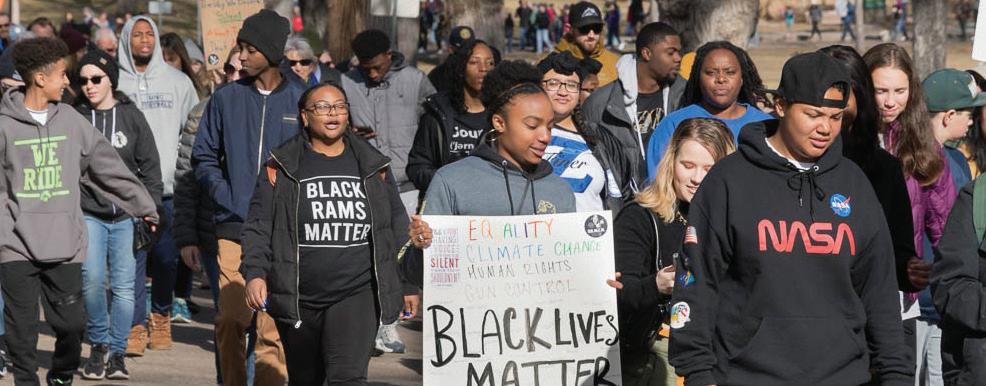
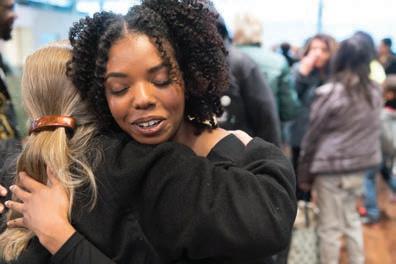

CSU and Fort Collins community members marched from Old Town Square to the Lory Student Center on Martin Luther King Jr. Day on Jan. 20. Check out more photos from the march and celebration at flickr.com/photos/coloradostateuniversity. Photo by William A. Cotton
Mixer for LGBTQ faculty, sta and graduate students scheduled for Feb. 4 in the Lory Student Center
The Pride Resource Center and the Graduate QTs student organization are hosting a mixer for LGBTQ graduate students, faculty and staff to foster community across the Colorado State University campus.
The mixer, sponsored by the Graduate School, will include remarks from Dean Mary Stromberger as well as faculty on Feb. 4 in Lory Student Center Room 382, 5:30-7:30 p.m. Food and refreshments will be served. Faculty, staff and graduate students can register at col.st/ZSa0m.
“We’ve heard feedback from our graduate students that they can sometimes feel isolated, and it’s difficult to build community,” said Pride Resource Center Director Dora Frias. “So for them, it’s critical to have a chance to network with faculty as part of the graduate school experience.” Frias added that the mixer offers the LGBTQ community at CSU the opportunity to connect with the Pride Resource Center and expand their network.
Members of the Graduate QTs also will be on hand during the event to share more information about their organization, a social and community group for queer- and trans-identifying graduate students.
“It is really important for LGBTQ graduate students to find mentors that share their identities and experiences,” said Graduate QTs President Chris Whitehead, a fifth-year Ph.D. candidate in chemistry. “However, there is no list available or system in place to link students with LGBTQ faculty/ staff. The goal of this event is to bridge this gap, connect LGBTQ graduate students with potential faculty/staff mentors, and establish a more visible graduate LGBTQ community.”
Established in 1997, the Pride Resource Center provides support for all CSU community members to explore and increase their understanding of sexual/romantic orientation, gender, and identity intersection.
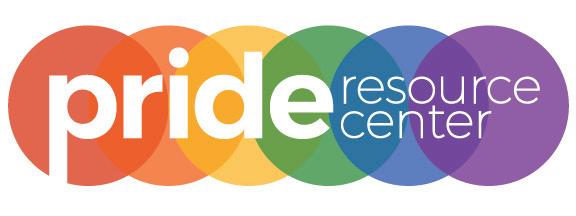
Here’s why 2020 is a leap year By Rachel Rasmussen
The start of 2020 brings a lot of excitement and interest to many people. For some, it’s the anticipation of what this next decade brings. For others, it’s the fact that Halloween is on a Saturday this year. But there’s another reason why 2020 is interesting to some people: It’s a leap year.
For those who don’t know, a leap year is when we add on an extra day to February. So instead of the calendar going Feb. 28 then March 1, it goes Feb. 28, 29, then March 1. There is a leap year roughly every four years.
The reason we have a leap year is so the Gregorian calendar, the one we typically use in the U.S., stays aligned with Earth’s rotations around the sun. In a non-leap year, there are 365 days. But is actually takes Earth around 365 days, fi ve hours, 48 minutes, and 45 seconds to make a full rotation around the sun. This is measured using the March Equinox when the sun shines directly on the equator and the length of the day is almost exactly equal to the length of the night. If we didn’t have a leap year roughly every four years, we would be losing about six hours off the calendar every year. After 100 years, our calendar would be off by about 24 days.
The idea of having leap years was introduced by the Roman general, Julius Caesar, over 2,000 years ago. But according to his calendar, the only rule to make a year a leap year is if it’s evenly divisible by four. This created too many leap years but it wasn’t corrected until over 1,500 years later with the introduction of the Gregorian calendar. Leap Year Criteria
Now, there are three criteria a year must meet in order to be considered a leap year. One is if it can be evenly divided by four, it’s a leap year. But if the year is evenly divisible by 100, it isn’t a leap year; unless it can also be evenly divisible by 400, in which case it is a leap year.
Those using the Gregorian calendar aren’t the only ones who have leap years. There’s a Chinese leap year that adds an entire month to the calendar every three years, the Jewish leap year adds a 13th month seven times in a 19-year cycle. One of the most accurate calendar systems comes from the Iranians. Their leap year isn’t based on mathematical rules like many of the other calendars, but rather by the timing of the equinoxes.
While a leap year in the Gregorian calendar occurs roughly every four years and for only one day, it isn’t impossible to have babies born on that extra day, in fact there are roughly 187,000 people born on Feb. 29, known as Leaplings. So then the question is asked, what do these people do for their birthdays when it isn’t a leap year? It depends on the individual Leapling, but some will just celebrate a day early or a day late, some will make their birthday a two-day event, and others will get together with other Leaplings and have an all-out celebration.
Regardless of if leap years are common knowledge in your household or not, they are important in our lives, keeping us synchronized with our planet’s orbit around the sun.
Volunteers needed to transcribe Colorado water history
By Jenna Allen
If you can decipher century-old cursive handwriting, Colorado State University Libraries needs your help.
The Water Resources Archive is launching a pilot project to crowd source transcriptions of three diaries written by Delph Carpenter, an infl uential water lawyer, state senator and river commissioner in Colorado in the early to mid-1900s.
Considered the “Father of Interstate River Compacts,” Carpenter kept daily diaries, which chronicle his activities over 15 years during the height of his career. He is best known for writing, negotiating and promoting the 1922 Colorado River Compact, a seven-state agreement on the allocation of water rights in the Colorado River basin, which remains in place today. The pilot will run through April 30, with volunteers transcribing the diaries through a popular online transcription platform, From the Page. If the pilot is successful, the remainder of Carpenter’s 14 diaries will be transcribed in the same way, to make a signifi cant piece of Colorado water history more accessible to modern researchers.
After editing by library staff , transcriptions will be freely available on Mountain Scholar, a digital repository for academic entities in Colorado and Wyoming, including Colorado State University.
With nearly 700 handwritten pages to transcribe, volunteers can transcribe as many or as few as they are able.
“Every little bit counts. We couldn’t do this without volunteers giving their time and eff ort,” Rettig said.

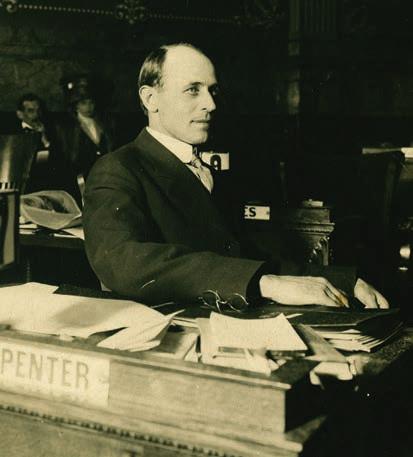
Learn more For information on how to volunteer, visit libguides.colostate. edu/waterhistory/transcribe. Questions about the pilot project may be directed to Patty Rettig, patricia.rettig@ colostate.edu.
GREAT DEALS ONLINE. DOWNLOAD THE RAM DEALS COUPON APP AND START SAVING.
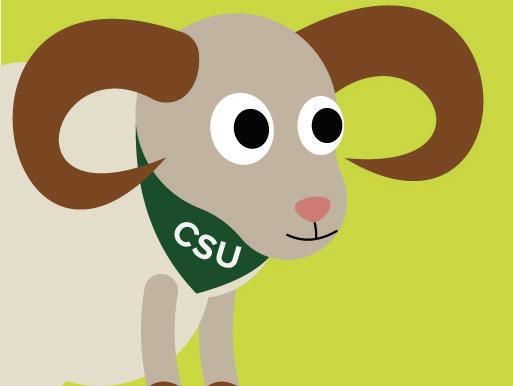
SPRING 2020 COUPON BOOK
RAM DEALS
14 | FEBRUARY 2020 CSU LIFE | FACULTY & STAFF Love & Money THE FINANCES BEHIND VALENTINE’S DAY Love & Money
Valentine’s Day is not only romantic, it’s big business too.
WHO’S BUYING? men tend to spend more
$183.63
$140.91 $161.96 $229.54
$96.79 $97.77
WOMEN WOMEN MEN 2018 2019 AVERAGE AVERAGE
PETS GET LOVE TOO! younger people spend more on their pets
MEN
HOW MUCH? last year saw a big jump
18.2 llion
20.7 llion
2019
2018
red roses 61% pink roses 27% mixed roses 12% 224 Million roses sold on V-Day in R O S E S B Y T H E N U M B E R S
MOST POPULAR GIFTS stick to what makes your signifi cant other smile
Source: ValentinesGiftsForHer
Night Out (16%)
25–34 $12.70
Cards (7.5%)
35–44 $4.08
65 + $1.44
Candy (15%) Jewelry (33%)
Gift Cards (11%)
BUDGETING TIPS
1
DINE-IN Nothing says “I Love You” more than a home-cooked meal. Your wallet will really appreciate it, too.
2
MOVIE NIGHT Cuddle up with a blanket on the couch. Who really wants to go sit quietly with a bunch of strangers anyway?
Clothing (17.5%)
Source: National Retail Federation
3
SAVE THE DATE Can’t get a reservation? Got a busy night? Take a rain check and spend some time when you’ve got it!
In honoring February as National Heart Month, let’s take some time to talk about heart health and raising heart rate.
Raising Heart Rate
How much heart rate raises during exercise is dependent on several factors, like your resting heart rate, medications, how hard you’re working, how long you’re working and the type of exercise you are doing.
Generally, the higher the heart rate, the more aerobic and cardiovascular benefit there is to the exercise. An easy way to estimate one’s maximal heart rate is “220-age.” A 20-year-old would have an estimated heart rate max of 200 beats per minute, while a 60-year-old would be at 160 bpm. This estimation of the max heart rate can give us a lot of information in terms of predictions and goals for workout intensity.
For the 20 or the 60-year-old, neither wants to be working at maximal heart rates very often or very long. When participating in light activity, heart rate should increase to be within a range of 57-63% of that estimate heart rate max (114-126 bpm for our 20-year-old and 91-101 bpm for our 60-year-old).
For moderate-intensity exercise, 67-76% of the estimated heart rate max (134-152 bpm for the 20-year-old, and 107-122 bpm for our 60-yearold). When working out in the vigorous-intensity range, 77-95% of their estimated heart rate max (154-190 bpm, and 123-152 bpm). Now, the more we know about you, the more we can manipulate these calculations to incorporate resting heart rate or perceived levels of exertion and further tailor exercise to you.
Remember, these are general guides that work for a large percent of the population. You could do the math for yourself or use general heart rate guides for age often found on specific exercise machines or charts in gym settings. What raises heart rate the most?
There is not a universal form of exercise that is always the highest heart rate raiser. For two different people running at the same speed, grade and distance for 30 minutes, one might achieve a heart rate high of 150 bpm and the other a heart rate high of 135 bpm.
Some of this relates to age and health history, among many other factors. Exercises that generally raise heart rate, and more so compared to other forms of exercise, are cardio exercises like walking, jogging, running, biking, swimming, etc. This can also be changed though if you prefer to make more strength-based moves. If you do them in a circuit style work out to adjust the length of time on a single exercise and rest periods, you can get a good cardio work out.
Do things that you enjoy and will lead you to future success. A 30-minute walk five times a week, runs or bike rides, strength, Zumba and yoga workouts. These are all great forms of exercise and can be manipulated in many ways to improve different components of fitness, all of which positively contribute to an enhanced quality of life and health outcomes.
Little Shop of Physics Open House on Feb. 29
By Chris Johnson
For nearly 30 years, the Little Shop of Physics has been creating interactive educational events while touring Colorado and nearby states. The Little Shop of Physics will be visiting the CSU Lory Student Center for an open house to give students, faculty and families the opportunity to experience hands-on science experiences.
This open house is open to the public at no charge and features over 300 homemade science experiments along with activities and presentations that will go on throughout the day. The open house begins at 10 a.m. on Saturday, Feb. 29, with presentations every hour until 4 p.m.
“The Million-Volt Tesla Coil” is one of the four interactive demonstrations and takes place at 12:30 p.m. and 3:30 p.m. The Tesla Coil has been a very popular event at previous open houses.
“The coolest part of [the Tesla coil] is that it sends electricity through the air so you can safely light a lightbulb and transfer electricity through you,” Adam Pearlstein, the assistant coordinator for LSOP, told the CSU Collegian after the 2017 open house.
Other presentations include the “Jærmuseet Science Circus” (10:30 a.m. and 1:30 p.m.) and “Discover Your Inner Scientist” (11:30 a.m. and 2:30 p.m.). The 4 p.m. finally program is titled “Plush Projectiles” and takes place on the plaza east of the LSC.
While most parking on CSU campus is complimentary on weekends, check the CSU Parking and Transportation website for further information.

In Redeeming Work: A Guide to Discovering God’s Calling for Your Career, CSU Professor Bryan Dik explores career development and the science behind career decision-making and meaningful work.
When asked what inspired him to tell this story, he explained how in his career in counseling psychology, he and almost all faculty see students who struggle when deciding what path to take. Being a person of faith, he had been watching how the global faith and work movement has been building up over time, all the while missing a key voice.
“I’ve followed this movement closely within the Christian community,” he stated. “It struck me how most of this conversation was unfolding without much awareness of the science of career development and meaningful work.”
The thought of writing a book sounds daunting and Dik admitted that it was diffi cult, but also something he felt compelled to do.
“When an author is overwhelmed by curiosity and passion for a particular topic, and driven by a sense that an important perspective needs to be shared that isn’t currently present within an ongoing conversation, it creates a huge amount of motivation,” he explained.
This was the encouragement Dik needed to take on this extra project on top of his faculty responsibilities. From start to fi nish, the book took two years to complete, and Dik said that if he felt a similar calling to a project in the future he would do it all again.
Integrated ideas
Additionally, these ideas have been integrated into his work in multiple ways. The ideas about the science of vocational psychology and evidence-based career counseling practice are topics that are already a part of his courses at CSU. He also has worked to develop PathwayU, an online career assessment system, in partnership with jobZology, a company he founded through CSU Ventures. It is used by many colleges in helping students set their path from recruitment to retirement.
But it all comes back to where the ideas stemmed, which is with the students.
“I am privileged to provide support for many students of faith who are grappling with how they might forge an integrated path forward, recognizing their gifts and honoring their desire to pursue their callings as whole persons,” Dik explained.
His passion for helping those students fi nd their way shows not only in his book and the programs he has helped develop, but also in the way he speaks about why this all came to be: a focus on

fi nding a space for all and helping individuals succeed.
Redeeming Work: A Guide to Discovering God’s Calling for Your Career was published in January and can be found at the CSU Bookstore.
HOMEBUYERS CLASS DISCOVER THE BENEFITS | GET YOUR QUESTIONS ANSWERED





FEBRUARY MARCH APRIL 4, 11, 18 3, 10, 24 7, 14, 21 UPCOMING DATES
LEARN MORE ABOUT THE COURSE ONLINE http://www.ocl.colostate.edu/homebuyer-class


OFF-CAMPUS LIFE
FREE CATERING DELIVERY ON CAMPUS Signature Wraps and Cookie Platters are perfect for catering faculty meetings!


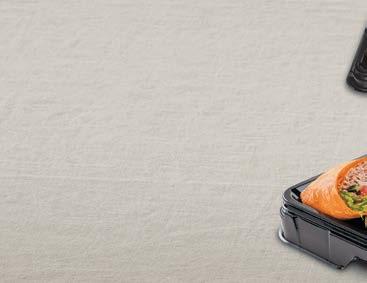

At participating restaurants. Subway® is a Registered Trademark of Subway IP LLC. © 2020 Subway IP LLC.

$ 10 off! Get $10 off catering orders of $100 or more. Offer expires May 31, 2020. Valid at participating LSC, Lake St Parking Garage and Campus West restaurants only. No cash value. Not for sale. Coupon must be surrendered with purchase. One time use. One coupon per qualifying item(s). Cannot be combined with promotional offers. Void if transferred, sold, auctioned, reproduced, purchased or altered, and where prohibited. Subway® is a Registered Trademark of Subway IP LLC. © 2020 Subway IP LLC.
Campus Trivia with Russ Schumacher
Dr. Kathlene Waller is a history buff – both Fort Collins and CSU – but still had to Google around to fi nd the exact year when Colorado Agricultural College fi elded its fi rst football team. The inaugural season in 1893 ended with a record of 3-5 for the Aggies, but don’t blame the head coach: There’s wasn’t one until the following year.
Waller, the medical director of the CSU Health Network, is such a local history buff that she has also authored a children’s book about Fort Collins’ historic Birney the Streetcar, with illustrations by her husband, Kevin Mabry. Waller has been with CSU for 30 years, after receiving her M.D. from the University of Iowa. For having her answer chosen at random from all the correct submissions, Waller received a special collection of sesquicentennial-themed swag, including a bandana autographed by State Climatologist Russ Schumacher, the winningest Ram to ever appear on Jeopardy! Feb. 11 marks CSU’s founding 150 years ago. This month’s question goes back almost that far.

Q. The fi rst academic building at Colorado Agricultural College was known as Old Main when it burned down in CSU’s centennial year. What building, now the oldest existing building on campus (and still in use), was constructed as the fi rst student residence hall? Email your answer to csulife@colostate.edu with February Trivia in the subject line by Feb. 19. Good luck!




